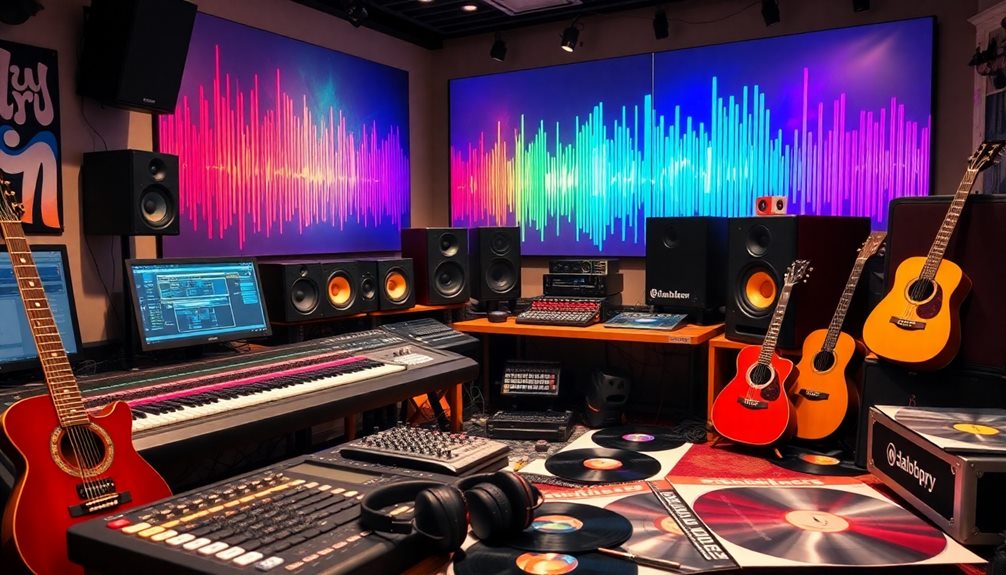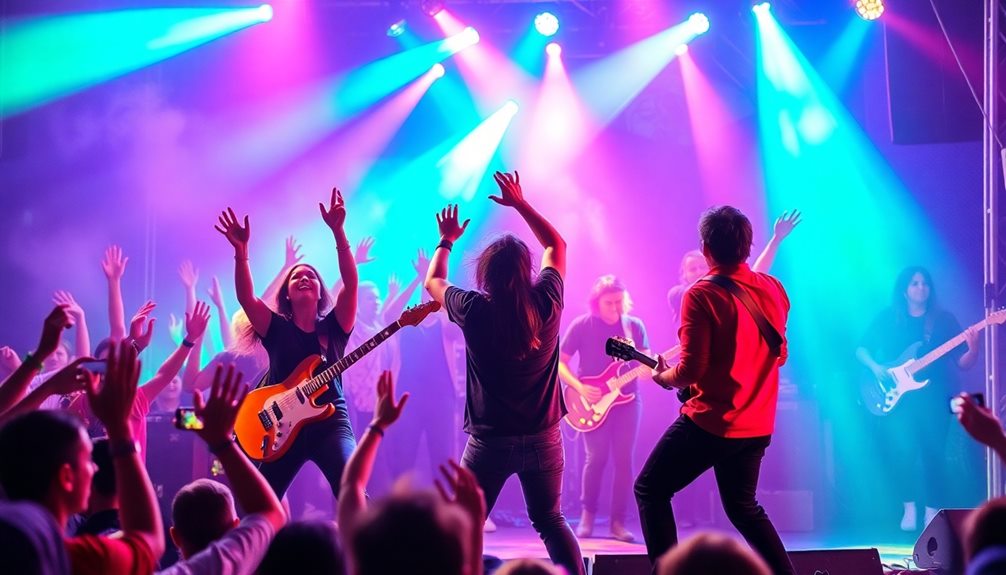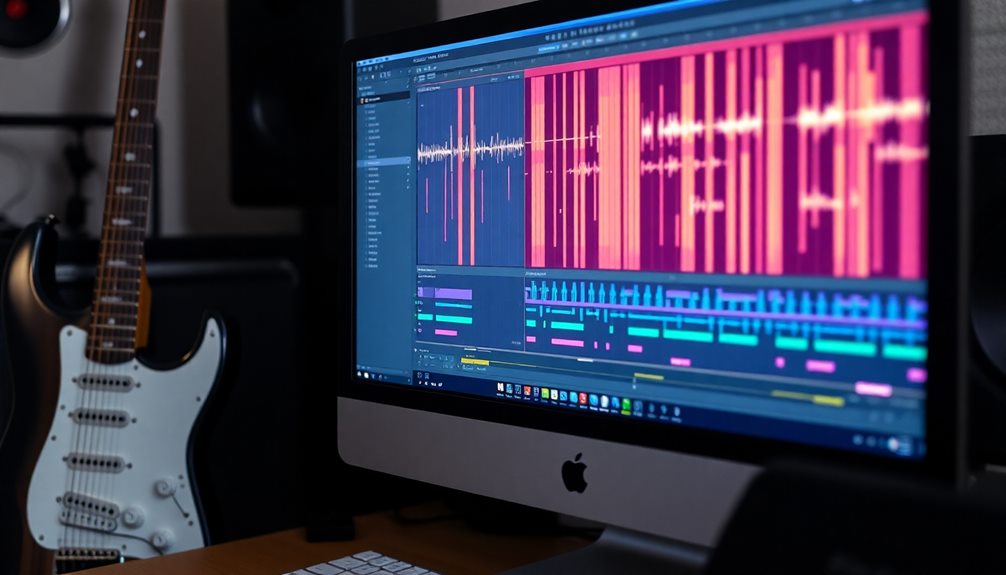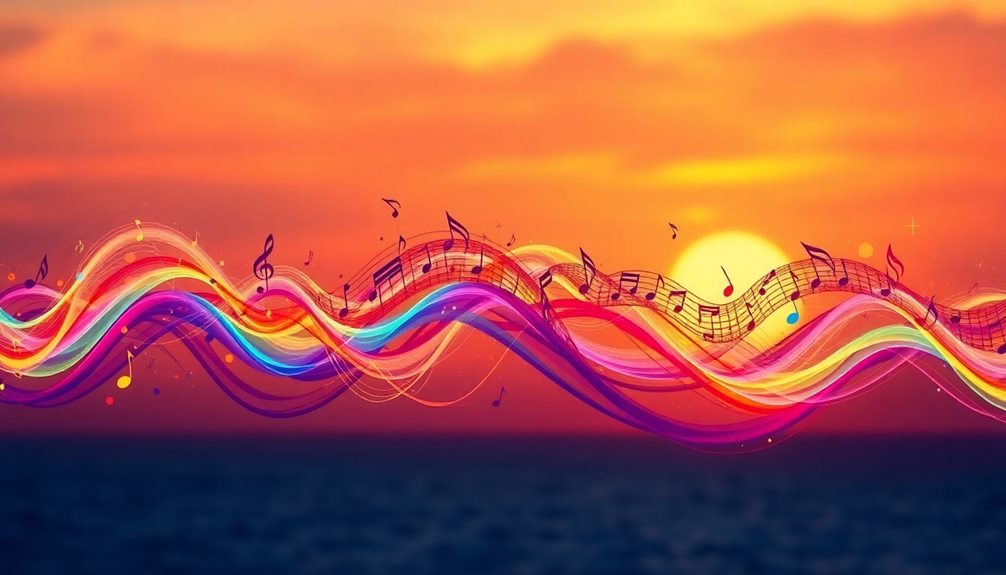Music production libraries are fantastic places to discover the perfect track for your project! With a wide variety of genres, you can find anything from joyful tunes to suspenseful sounds. Most tracks are best between 2:00 and 2:50 minutes long, giving you lots of material to work with. Plus, many libraries offer variations like instrumental versions and shorter edits. This allows you to match the music with your visuals perfectly. Don't forget to check licensing terms to avoid any bumps along the way. There's so much more to explore, and you'll be excited to uncover fantastic sounds that fit your needs!
Key Takeaways
- Ideal track lengths for submissions are between 2:00 and 2:50 minutes, maximizing usability for projects.
- Incorporate variations like stems and instrumental versions to enhance track adaptability for different media needs.
- Use advanced search features to filter tracks by mood, genre, key, and BPM for tailored selections.
- Ensure tracks maintain a balance between music and dialogue, avoiding overpowering solos or vocals.
- Collaborate with music libraries to understand preferences and improve submission success rates.
Ideal Track Lengths
When it comes to submitting tracks to music libraries, aiming for a length between 2:00 and 2:50 minutes is ideal. This range gives you enough time to showcase your creativity, while also keeping things concise. Tracks that are too long can waste time because most projects only use snippets. So, if your track is over 3 minutes, it mightn't be the best choice.
You might wonder about shorter tracks. Well, while pieces under 30 seconds can work, they need to have enough content for editing. It's all about making your music usable for different purposes. Libraries often ask for variations like 60 or 30-second edits, plus different formats like stems. This flexibility helps them fit your music into various projects.
Understanding the ideal track lengths preferred by different libraries is super important. It can make a big difference in how well your music is received.
Emotional Storytelling in Music
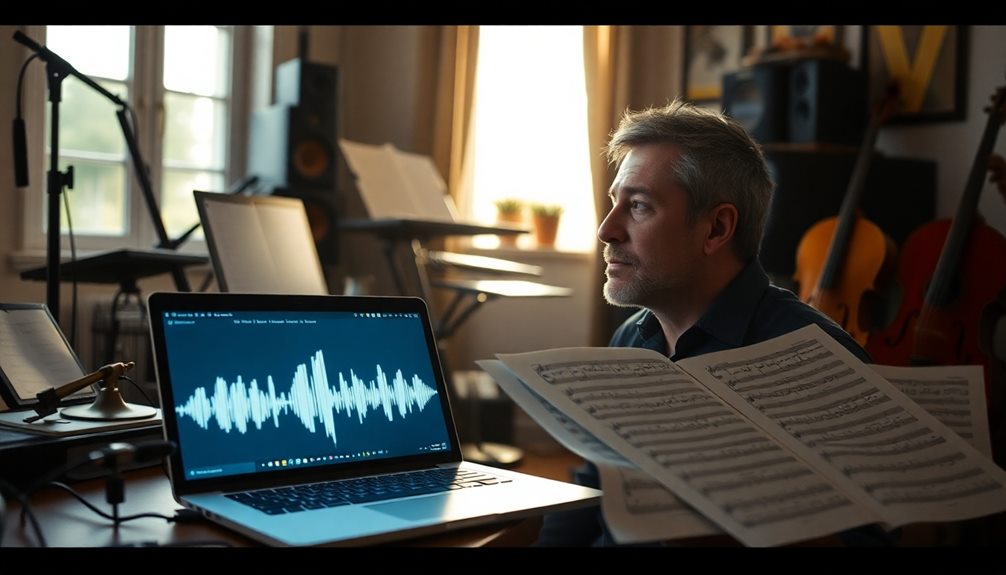
In today's media landscape, emotional storytelling in music plays a pivotal role in enchanting audiences and enhancing visual narratives. When you choose the right music selection, you can really boost the feelings in your project! Music tracks in production libraries are crafted to evoke specific emotions. For example, suspenseful cues can make viewers hold their breath, while cheerful tunes can spark smiles.
Here's a quick look at how different music styles can match emotions:
| Emotion | Music Style |
|---|---|
| Suspense | Investigative Cues |
| Joy | Comedic Cues |
| Sadness | Melancholic Melodies |
| Inspiration | Uplifting Themes |
Using the right track helps tell your story without drowning out vocals or other sounds. You'll find that effective music selection can change how people feel about your visuals. Plus, the flexibility of library tracks allows you to create deeper emotional connections. So, whether you're working on a film, an ad, or a presentation, let music enhance your storytelling magic!
Track Variations and Usability
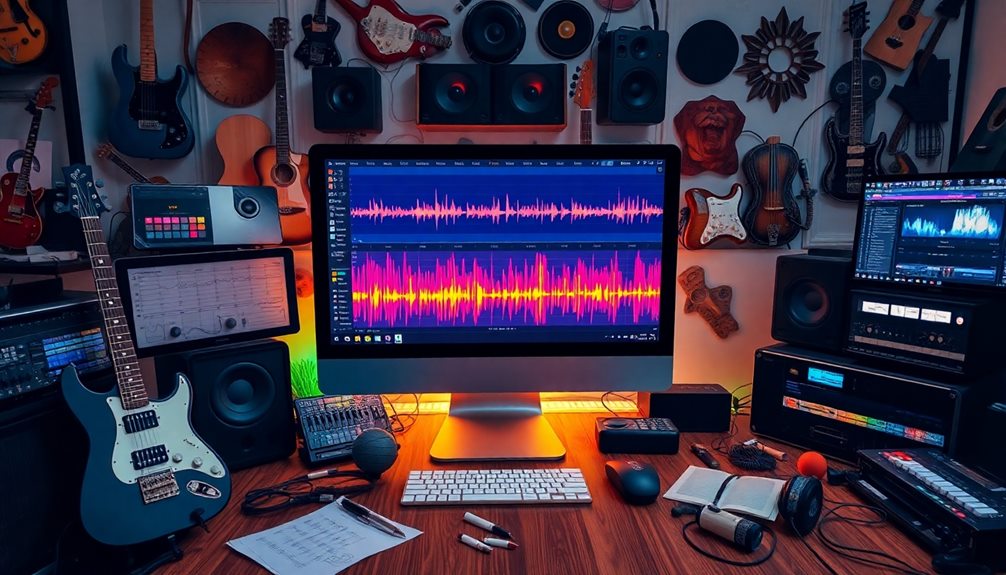
To maximize the impact of your media projects, incorporating a variety of track variations is vital. Think about it—when you have different options like stems, instrumental versions, and cutdowns, you can customize the sound perfectly for each project!
You'll want tracks that are around 2:00-2:50 minutes long, giving you enough material to edit while still fitting the shorter snippets often needed for commercials and presentations.
Usability really shines when tracks are designed to support voiceovers. This means avoiding overpowering solo instruments that might distract from your story. Instead, you want music that enhances the narrative.
Offering fun options like stingers and bumpers also helps cater to specific project needs, making your music selections even more flexible.
And don't forget about high-quality mixes! Tracks without vocals are essential for broader applications, ensuring that the music complements your visual content beautifully.
With these track variations, you'll find the perfect soundtrack for your media projects, making them even more engaging and enjoyable for your audience. So, explore those music libraries and discover all the exciting possibilities!
Selecting the Right Track

Finding the right track can greatly elevate your media project. When you're selecting a track, think about the emotions you want to evoke. Do you need suspense for an investigation or an upbeat vibe for a promotion? Picking the right mood sets the stage for your audience.
Additionally, consider the synergy between the track and your visual elements, as effective sound design can enhance the overall experience. This consideration is crucial for achieving a polished final product, particularly when utilizing sound recording techniques that complement your musical choices.
Aim for tracks that are between 2:00 and 2:50 minutes long. This length gives you plenty of material for editing, making it easier to fit your project perfectly.
Also, look for tracks with variations like stems or alternate mixes. These options let you customize the sound, creating a unique feel for your production.
Be careful with overpowering solos or vocals. They can distract from your narrative and make it tricky to blend with voiceovers or dialogue.
Lastly, use music libraries with curated playlists and advanced search tools. These features help you find just the right track more quickly, streamlining your music licensing process.
Selecting the perfect track doesn't have to be hard. With these tips, you'll find the ideal music to enhance your project and create an unforgettable experience for your audience!
Submission Strategies for Producers
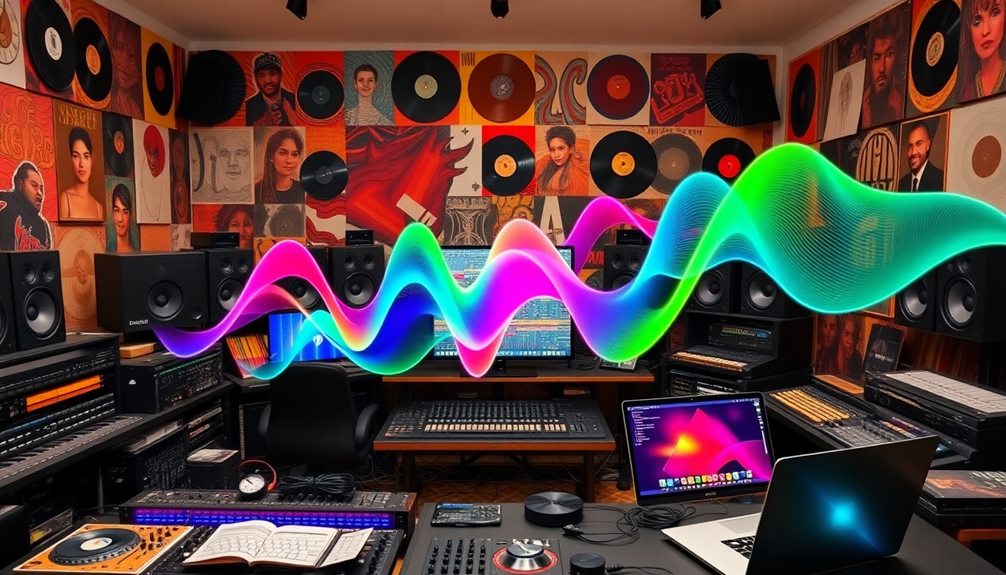
When you're ready to submit your music, think about keeping your tracks between 2 to 2:50 minutes long.
It's also super helpful to include different versions and variations, like stems, so libraries can easily use your music in different ways.
Plus, chatting with the libraries about what they want can really boost your chances of getting your music accepted!
Ideal Track Length
In the competitive world of music production, understanding the ideal track length for submissions is essential for success. Most music libraries prefer tracks that are between 2:00 and 2:50 minutes long. This length gives you enough content for editing while keeping it concise.
Think of it this way: you want to create tracks that are adaptable. Including variations, like :30 cut downs and stems, can really enhance your track's usability for different projects.
You should always aim to make your tracks editable. Producers love tracks that allow for flexibility, especially when they need to pair the music with voiceovers or other media. Shorter tracks can work if they provide enough material for editing, but be careful with longer tracks. They often lead to wasted time, as only snippets are usually used.
Don't forget to communicate directly with music libraries about their specific submission preferences. Doing this can greatly increase your chances of successful placement.
Versioning and Variations
To stand out in the competitive landscape of music production, you should prioritize versioning and variations in your submissions. Offering multiple versions of your tracks can make all the difference. Think about including stems and alternate mixes. This gives potential buyers the flexibility they need, making your music more appealing.
You should also consider adding different edits, like :30 cut downs and longer formats. These variations help cater to various project needs and increase your chances of getting placed in different media applications.
Keep your tracks between 2:00 and 2:50 minutes long. This length meets common library specifications and provides enough material for editing without dragging on.
Don't forget about instrumental versions! Many projects require tracks without vocals so that voiceovers can shine through.
Clear communication with music libraries about their specific submission preferences is key. By doing this, you can improve your chances of successful placements and make your music more usable.
Direct Library Communication
Effective communication with music libraries can greatly boost your submission success. When you reach out, don't hesitate to ask about their specific preferences! Direct communication helps you understand what they're looking for, making your submissions much stronger.
Keep your demos concise, ideally between 2:00 and 2:50 minutes. This matches library submission standards and increases your chances of acceptance. Adding different formats, like stems and alternate mixes, can also make your tracks more versatile, allowing editors to use them in various projects.
Consider including narrative-oriented material in your submissions. This type of music tells a story and shows how your track fits into potential projects, which can be very appealing.
Lastly, remember that each library has its own formatting needs. Understanding these requirements is essential, as adapting your tracks accordingly can greatly impact your success.
Accessing Diverse Music Genres
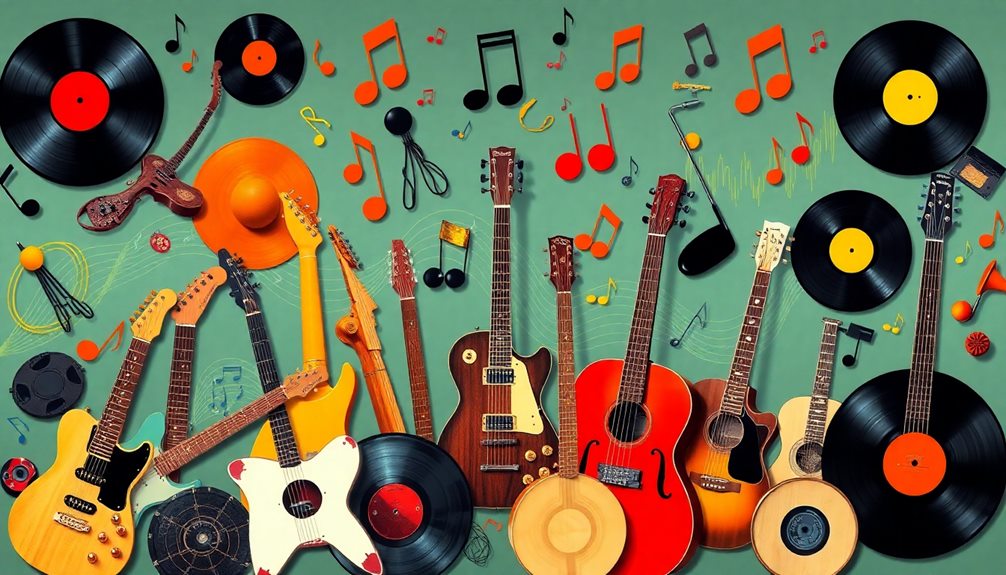
Accessing a rich variety of music genres is essential for any creator looking to enhance their projects. With a great music library at your fingertips, you'll discover tracks that perfectly match your vision.
Imagine needing the perfect background sound for a video, or a chill beat for your podcast; these libraries offer genres like Lofi, Hip Hop, and Cinematic to suit every need.
You'll find thousands of high-quality tracks produced by Grammy-winning musicians, which makes your choices even more exciting! Plus, expertly curated playlists help you quickly find the right music for films, ads, or social media posts. No more endless searching!
What's even better is the advanced AI search features that let you filter by mood, genre, key, and BPM. This makes discovering new sounds a breeze!
Most royalty-free music libraries have over 5,000 songs, ensuring you can access diverse options without worrying about licensing issues.
Licensing and Legal Considerations
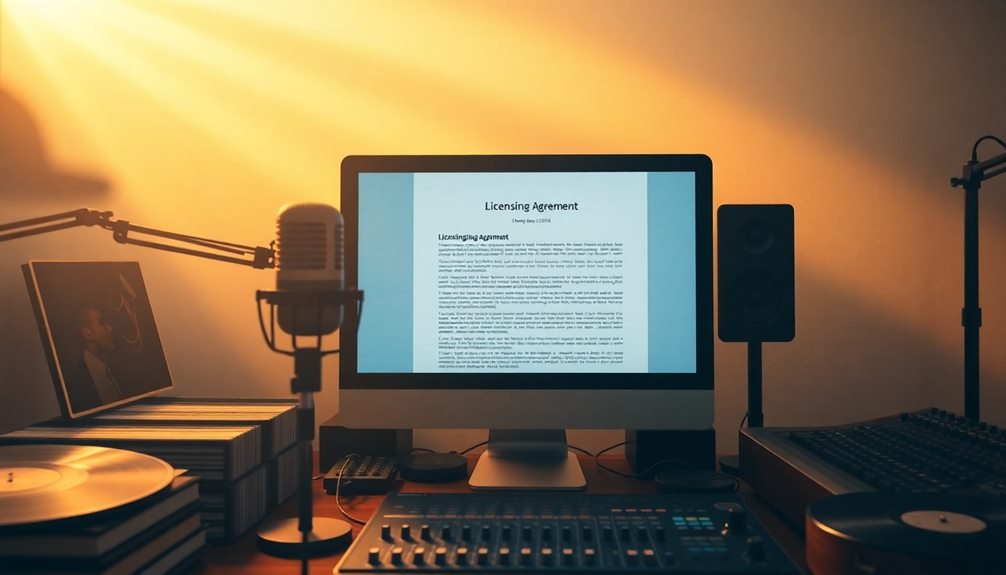
Steering through the world of licensing is essential for anyone using music in their projects. Even if you're using subscription plans, remember that royalty-free music is still copyrighted. You need the right licensing to avoid legal troubles. Companies like Soundstripe make this easier, handling the tricky details of securing music permissions for you.
Here's a quick look at important licensing aspects:
| Aspect | Description | Importance |
|---|---|---|
| Licensing Agreements | Rules for using music | Protects against legal issues |
| Cue Sheets | Lists of licensed songs for TV projects | Grants legal permission to air music |
| Royalty-Free Music | Music that doesn't require additional fees | Cost-effective for creators |
| Penalties for Violations | Fines can reach up to $150,000 | Highlights the need for compliance |
Collaboration and Integration Tools
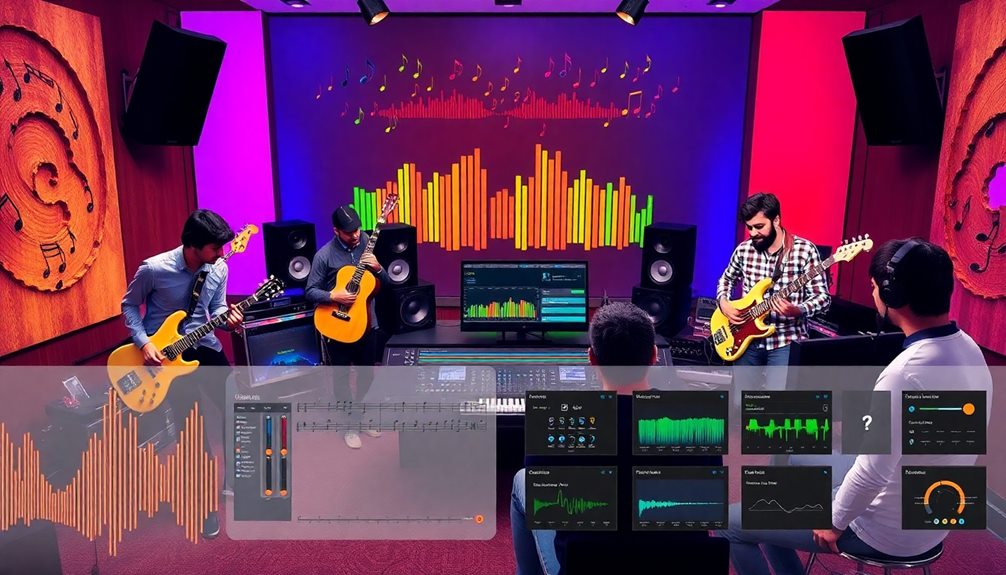
Often, music production teams rely on collaboration and integration tools to enhance their workflows and streamline the incorporation of music into projects.
These tools, like Adobe Premiere Pro and Frame.io, make it easier to add the perfect track to your videos. You can work together with your team in real-time, discussing ideas and making changes right on the spot!
Music APIs are another fantastic way to integrate music directly into mobile apps and video games. This means users get to enjoy a seamless experience, making everything more fun!
Plus, with stems and alternative versions of tracks, you can mix and match sounds to fit your project's needs perfectly.
Engineers also benefit from tools designed specifically for them, ensuring that every beat aligns beautifully with the visuals.
This clever combination of audio and video helps tell a story in a way that feels just right.
Artist Relations and Fair Compensation
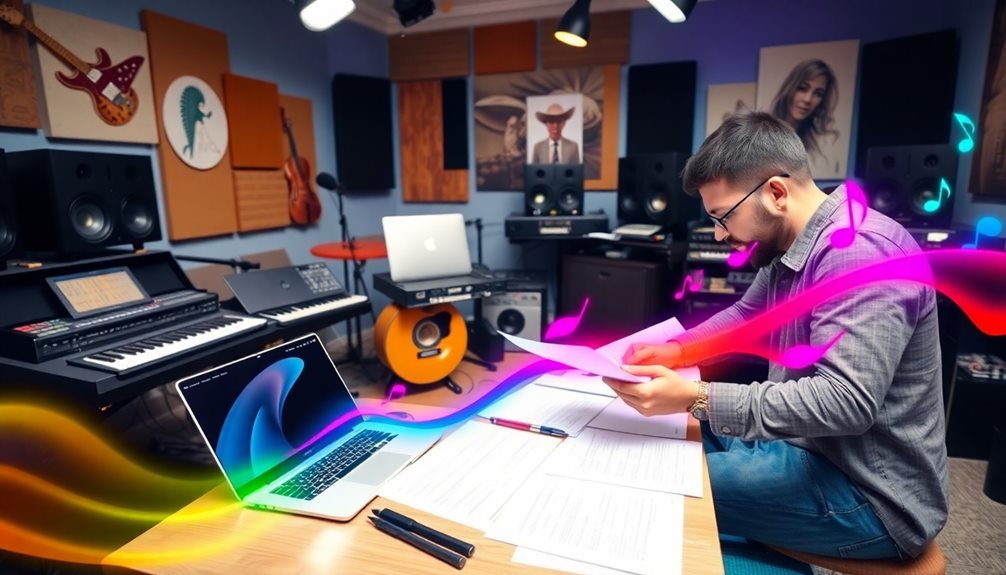
Let's talk about how important fair payment models are for artists in music production libraries! Supporting independent musicians not only guarantees they receive fair compensation but also fosters a sense of community and collaboration in the music industry.
When you support independent musicians, you help them shine while guaranteeing they get paid fairly for their amazing work. This not only builds strong relationships but also makes the music library even more exciting with fresh and diverse sounds!
Incorporating diverse sounds can enhance your top wellness tips for a healthier you by uplifting your mood and creating a positive atmosphere.
Fair Payment Models
Fair payment models are essential in fostering strong artist relations and ensuring fair compensation within music production libraries. When artists feel valued, they create amazing music that you can enjoy.
This approach not only enhances the quality of music available but also encourages community engagement among artists, leading to innovative collaborations. Here are some ways fair pay benefits everyone involved:
- Transparency: Artists know exactly how much they'll earn, which builds trust.
- Support for Emerging Musicians: Many libraries focus on independent talent, helping them shine.
- Diverse Content: Fresh tracks from various artists keep your playlist exciting.
- Predictable Income: Flat-rate payments or royalties provide artists with financial security.
These models promote fairness and creativity in a competitive marketplace. By prioritizing fair pay, music libraries make it easier for you to discover new sounds while ensuring musicians receive appropriate earnings.
This way, you're not just finding the perfect track; you're also supporting artists in their journey. When you choose music from libraries that value fair compensation, you're making a difference in the creative world.
Supporting Independent Artists
Supporting independent artists is a vital aspect of music production libraries that not only enhances the music industry but also nurtures creativity. When you choose to work with music libraries, you're helping create direct partnerships that guarantee fair compensation for these talented musicians. This means that independent artists can earn money while sharing their music with the world!
These libraries often spotlight diverse talent, allowing independent artists to gain visibility. When their songs get placed in movies, commercials, or online videos, it opens doors for even more opportunities.
Music libraries keep things exciting by frequently updating their collections with fresh sounds from these artists. This dynamic environment inspires creativity and innovation.
Fair compensation models play an important role, too. They provide transparent revenue sharing, so artists receive proper royalties for their hard work.
By supporting independent artists, music libraries enrich our music landscape. You'll find a wider variety of tracks available for licensing, making it easier for you to find that perfect sound for your projects.
Enhancing User Experience Through Feedback

User feedback acts like a compass, guiding music production libraries toward a more satisfying experience for creators and listeners alike. When you share your thoughts, you help shape a library that truly meets your needs!
Here's how your feedback enhances the experience:
- Better Playlists: Your input refines playlists, making them more enjoyable and relevant.
- Discover New Music: Tailored suggestions lead you to fresh artists and exciting genres you might love.
- Community Connection: Sharing your opinions fosters a sense of belonging, connecting you with fellow music lovers.
- Quality Assurance: Continuous improvement based on your feedback guarantees that the royalty-free music stays exceptional and trendy.
As you engage with these libraries, remember that your voice matters! Positive testimonials from creators like you show that feedback is essential.
Each suggestion you make helps maintain high standards and keeps the library current. So, don't hesitate to share your thoughts. By doing so, you're not just improving your experience; you're also contributing to a vibrant music community.
Together, let's make the world of royalty-free music even more delightful!
Frequently Asked Questions
How Do I Find the Perfect Background Music?
To find the perfect background music, explore AI-powered search tools that filter by mood, genre, and BPM. Curated playlists can simplify your choices, ensuring the music aligns with your project's emotional tone and storytelling.
Who Has the Best Music Library?
When you're looking for the best music library, consider your needs. Platforms like Airbit or Alibi Music offer curated options, while Jamendo and Artlist provide unique benefits. Explore each to find what suits you best.
What Is the Best Way to Organize Your Music Library?
Organizing your music library can feel chaotic yet rewarding. Start by categorizing tracks into genres and moods. Implement a tagging system for easy searchability, and regularly update to keep your collection fresh and relevant.
What Is the Best Music Library for Content Creators?
When choosing the best music library for your projects, consider options like Soundstripe or Artlist. They offer unlimited downloads and straightforward licensing, allowing you to focus on creating great content without legal worries.
Conclusion
Finding the perfect track is like uncovering a hidden treasure that makes your project shine! With the right music, you can tell a story that dances in the hearts of your audience. Remember to explore different tracks and share your thoughts, because every piece of feedback helps everyone grow. So immerse yourself in the world of music production libraries, let your creativity soar, and create something magical that brings joy to all who hear it!
